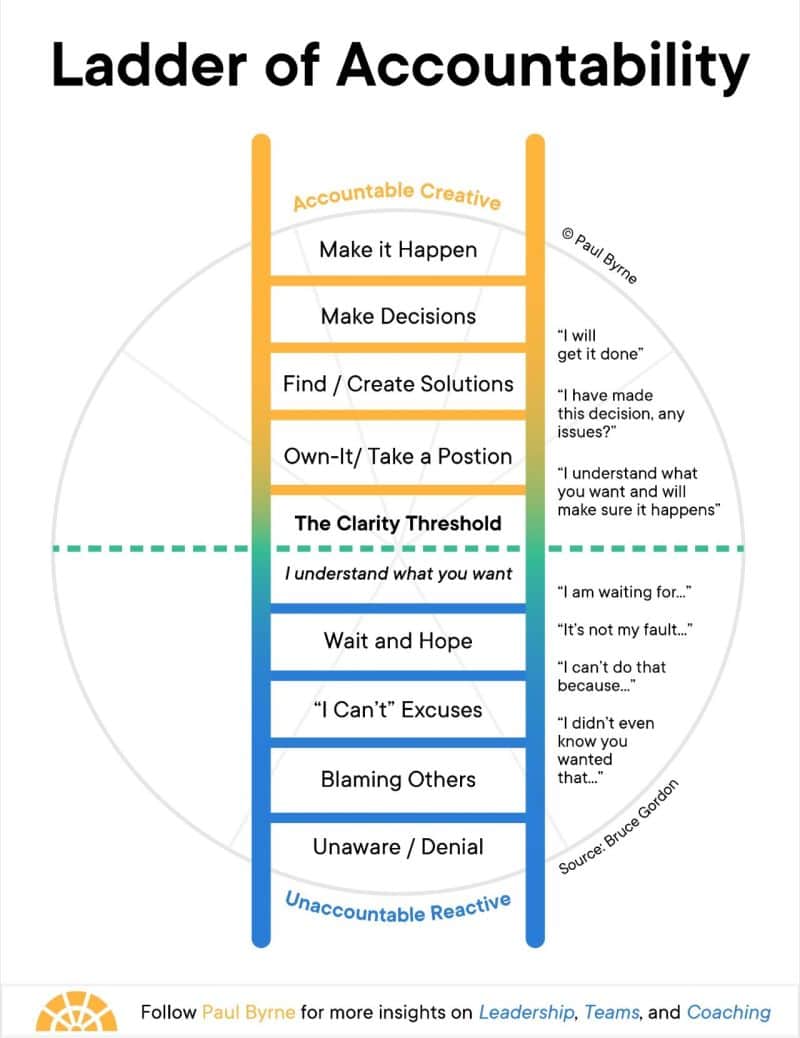
Have you ever felt stuck because expectations weren’t clear? You're not alone.
A Gallup study found that only 50% of employees know what’s expected of them at work.
Without clarity, it’s easy to avoid accountability and struggle to grow.
But by learning to climb the "Accountability Ladder," you can change this.
In this guide, I’ll show you how to shift your mindset and take real steps toward building personal and professional accountability.
Let's dive in!
What is the Accountability Ladder?

The ladder of accountability is a simple way to understand how we either take responsibility for our actions or make excuses to avoid them.
Think of it as a series of steps. At the bottom, you’ll find people who avoid accountability, blame others, and always have reasons why things didn’t go as planned.
But as you move up, you start owning your decisions and actions more.
At the top, you become highly accountable—the kind of person who faces challenges head-on admits mistakes and works to find solutions. It’s a tool that helps you reflect on where you are and how to improve.
The Stages of the Accountability Ladder: Explained

Stage 1: Denial – Avoiding responsibility
In the first stage of the accountability ladder, denial, people avoid accepting any responsibility.
They act as if the problem doesn't exist or insist it has nothing to do with them.
They might ignore the issue or pretend it’s not their fault, hoping to avoid any consequences.
This stage is about refusing to face reality, which only makes things worse in the long run.
Stage 2: Blame – Shifting responsibility onto others
At this stage, people shift responsibility to someone else. Instead of owning up to mistakes or problems, they point fingers and say, “It’s not my fault.”
This deflects the issue, but it doesn’t solve anything.
Blaming others might feel like a quick fix, but it prevents real progress and keeps people stuck in the problem.
Stage 3: Excuses – Rationalizing failures and mistakes
In the excuses stage, people begin to rationalize why something went wrong.
They might admit there’s a problem, but they’ll come up with reasons why it wasn’t their fault or why they couldn’t do anything about it.
Making excuses allows people to acknowledge the issue without fully owning up to their role in it.
Stage 4: Wait and Hope – Expecting others to take action
This stage is all about passivity. People wait and hope someone else will step in and fix the problem.
They understand there’s an issue but believe it’s someone else’s responsibility to take care of it.
It’s a mindset that stalls progress because no action is being taken. Nothing changes while you’re waiting for others to solve the issue.
Stage 5: Acknowledgment – Recognizing personal responsibility
At this point, people start to acknowledge that they are responsible for their actions.
They stop blaming others or making excuses and accept their role in the situation.
This is the first real step toward accountability because it’s where ownership begins. Recognition is key to moving forward and finding solutions.
Stage 6: Solutions – Taking proactive steps toward improvement
Here, people begin to focus on solutions. Instead of just recognizing the problem, they start looking for ways to fix it.
They take proactive steps to improve the situation, showing a commitment to solving the issue.
This stage is where real change starts to happen because it’s all about moving toward a positive outcome.
Stage 7: Action – Fully owning the outcome and executing changes
In the final stage, people take full ownership of both the problem and the solution.
They take deliberate actions to execute the necessary changes and follow through until the issue is resolved.
This stage represents the highest level of accountability, where you not only find solutions but also make sure they’re implemented.
It’s the ultimate demonstration of being highly accountable.
How to Move Up the Accountability Ladder

Start by Shifting Your Mindset
If you find yourself stuck in blaming others or making excuses, the first step to moving up the accountability ladder is changing how you think.
Instead of focusing on what went wrong or who’s responsible, start asking, “What can I do to improve this situation?”
Research shows that a proactive mindset increases problem-solving abilities.
By taking ownership of your actions, you’re already making progress toward becoming more accountable.
Take Responsibility for Your Actions
A key habit in accountability is owning your mistakes, even when it's hard. This doesn’t just help you grow—it also builds trust with others.
Studies show that leaders who admit their mistakes gain more trust from their teams compared to those who don’t.
Reflect on your day and ask, “Where could I have done better? Where did I avoid responsibility?”
Writing this down helps you see patterns where you can take more ownership.
Use Feedback for Growth
While self-reflection is powerful, feedback from others is just as crucial. Often, others can see gaps in your accountability that you may not notice.
Be open to their input and use it as a learning opportunity as regularly seeking feedback can improve your performance.
With consistent effort, you can rise up the accountability ladder and become more reliable in your daily actions.
3 Key Benefits of Climbing the Accountability Ladder

Improving Personal Relationships and Workplace Dynamics
When you take more responsibility for your actions, your relationships improve. People trust you more because they know you’ll own up to your part.
At work, this builds a stronger team. Instead of blaming others, everyone works together to find solutions.
This makes the work environment more positive and productive.
How Accountability Makes Better Leaders
Good leaders take responsibility for their actions and decisions. When a leader is accountable, the team follows their example.
This creates a work culture where everyone feels comfortable taking ownership, leading to better teamwork and results.
Productivity, Trust, and Personal Growth
Accountability leads to better productivity—people work faster and more efficiently when they stop making excuses.
It also builds trust with others, as they see you as reliable.
On a personal level, owning your actions helps you grow, because you learn from mistakes and improve over time.
Common Challenges in Staying Accountable
Staying accountable can be tough for a few reasons.
People might avoid it because they’re afraid of failing, feel insecure, or don’t know what’s expected of them.
These things make it easy to lose focus or give up.
To get past this, you need to face those fears and break tasks down into smaller steps, which makes it feel easier to make progress.
Using an accountability partner app can also help a lot.
Apps like GoalsWon pair you with a real coach who checks in every day, helping you stay on track.
Studies show that working with a coach can boost your chances of reaching your goals.
Regular check-ins and reminders make it easier to stick with your commitments, even when challenges pop up.
Accountability Ladder in the Workplace
Leaders can use the accountability ladder to help everyone at work take responsibility for their actions.
When teams learn to stop making excuses and start owning their work, it creates a culture where people get more done and work better together.
Leaders can introduce accountability by:
- Setting clear goals
- Holding regular check-ins
- Giving honest feedback
These simple steps help everyone stay on track and feel responsible for their part.
Being open and clear with communication is also important. When leaders share feedback and expectations, it encourages others to step up.
If you want to see real-life examples of how you can use accountability in the workplace, check out my post, "Real Life Examples of Accountability in the Workplace."
Tools and Resources for Personal Accountability

Books, Apps, and Tools
There are lots of helpful resources out there to keep you on track with your personal accountability journey.
Some popular books include "The Power of Habit" by Charles Duhigg and "Atomic Habits" by James Clear.
These books break down how small actions can lead to big changes.
For apps, you can try Todoist for task management or Habitica, which turns your goals into a fun game. Both help you stay focused and consistent.
Journaling, Goal-Setting Apps, and Accountability Partners
Journaling is a great way to reflect on your progress. Writing down what you did well or where you could improve helps you stay honest with yourself.
Using goal-setting apps like Trello or Notion can help you break down bigger tasks into smaller steps, making them easier to achieve.
You can also find an accountability partner—someone who checks in with you and helps keep you motivated. They can be a friend, colleague, or mentor.
Regular Check-ins and Progress Reviews
One of the best ways to move up the accountability ladder is by having regular check-ins.
Set aside time weekly or monthly to review your goals (you can use an accountability planner to track your progress) and see how far you’ve come. This keeps you focused and allows you to adjust if things aren’t going as planned.
Whether it’s through an app, with a partner, or on your own, these progress reviews are key to staying accountable.
Final Thoughts
In this post, we talked about how to climb the accountability ladder—starting by changing your mindset and owning your actions.
We covered ways to reflect on your progress, get feedback, and set clear goals to help you grow personally and professionally.
Taking these steps can lead to more success and stronger relationships.
Ready to take action? Start climbing the accountability ladder today, and watch how it transforms your life!
